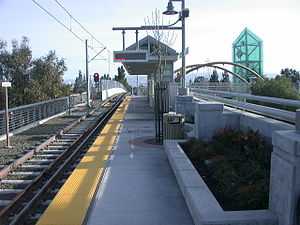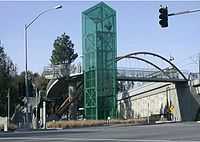Hamilton (VTA)
VTA light rail station | |||||||||||
|---|---|---|---|---|---|---|---|---|---|---|---|
 Hamilton station - looking northeast along the station's elevated platform. | |||||||||||
| Station statistics | |||||||||||
| Address |
850 East Hamilton Avenue Campbell, California | ||||||||||
| Coordinates | 37°17′38″N 121°56′11″W / 37.293998°N 121.93625°WCoordinates: 37°17′38″N 121°56′11″W / 37.293998°N 121.93625°W | ||||||||||
| Line(s) | |||||||||||
| Connections | Bus Route 82 | ||||||||||
| Other information | |||||||||||
| Opened | 2005 | ||||||||||
| Accessible |
| ||||||||||
| Owned by | VTA | ||||||||||
| Services | |||||||||||
| |||||||||||
| Location | |||||||||||
 | |||||||||||
Hamilton is a light rail station operated by Santa Clara Valley Transportation Authority (VTA). Hamilton is served by the Mountain View–Winchester light rail line. The station has a single track used by trains traveling in both directions. The platform of the station is elevated from street level.
Location
Address: 850 East Hamilton Avenue, Campbell, CA 95008
Nearest cross-streets: State Route 17 and Creekside Way
Geographic coordinates: 37° 17' 37.9" North, 121° 56' 11.2" West
Architecture/public art

Hamilton station has a dramatic glass elevator enclosure and distinctive pedestrian bridge that provides access to the platform and improves the station's aesthetics.
There is no public art currently on display at this station.
History
Hamilton station was built as part of the Vasona Light Rail extension project. This project extended VTA light rail service from the intersection of Woz Way and West San Carlos St in San Jose in a southwesterly direction to the Winchester station in western Campbell.[1]
The official opening date for this station was October 1, 2005.
The construction of this station and the rest of the Vasona Light Rail extension was part of the 1996 Measure B Transportation Improvement Program. Santa Clara County voters approved the Measure B project in 1996 along with a one half percent sales tax increase. The Vasona Light Rail extension was funded mostly by the resulting sales tax revenues with additional money coming from federal and state funding, grants, VTA bond revenues, and municipal contributions.[2]
Connecting transit
- VTA Bus Route 82 - Westgate to 21st & Mission
References
- ↑ "Vasona Project Description". Completed projects. Santa Clara Valley Transportation Authority. 2008-09-15. Retrieved 2008-11-16.
- ↑ "Making the Light Rail Connection: Expanded Service Adds 5.3 miles to System". Santa Clara Valley Transportation Authority. 2005-10-01. Retrieved 2008-11-16.
External links
 Media related to Hamilton (VTA) at Wikimedia Commons
Media related to Hamilton (VTA) at Wikimedia Commons
